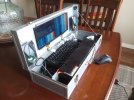Me, too!
I
love those!
They're a bit

- okay, pretty

noisy,
but the feeling is just
perfect.
Since production was stopped a long time ago, and you may only get an orignal one with your preferred layout e.g. by ebay at a high prize - if you're lucky,
one might be interested in that
unicomp owns the licenses to produce them.
I had a couple of original Ms and unicomp's (accidential pouring beverages on the kb cost me some...),
and can say they have 95% of the quality of the original IBM ones.
I already thought about to start a KB thread,
since I'm still looking for the perfect keyboard (what my wife is in shoes, I'm in keyboards - but I would be settled with one ?).

